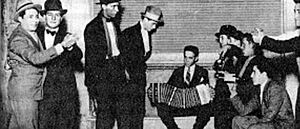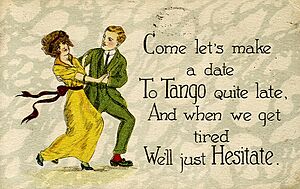History of the tango facts for kids
Tango is a famous dance and a type of music. It started in the port areas of Buenos Aires, Argentina, and Montevideo, Uruguay. These cities are on opposite sides of the Rio de la Plata river.
Contents
What Does "Tango" Mean?
No one is completely sure where the word 'Tango' comes from. One idea is that it came from African languages. Another idea is that the word 'tango' was already used in Andalusia, Spain, for a type of music. Later, it was used for the new dance style in Argentina and Uruguay.
How Tango Began
Tango grew from several different dances and music styles. These include the Cuban habanera, the Argentine milonga, and the Uruguayan candombe. It also has parts from the music of African communities in Buenos Aires. These African rhythms came from the candombe, which had quick, energetic movements.
The milonga was a mix of the Spanish-Cuban habanera and European polka music. The mazurka, another European dance, also helped shape Tango. Over time, all these different styles came together in the outer parts of Buenos Aires. This is how Tango as we know it began.
Even though Tango's modern forms grew in Argentina and Uruguay, earlier records show Tango dances in Cuba and Spain. There is also a flamenco Tangos dance that might share a common past with an old European minuet dance. Many sources agree that African communities and their rhythms were very important. Also, the instruments and skills brought by European immigrants helped define Tango. This connected it to the salon music styles that Tango later influenced, especially when it became popular in Paris in the early 1900s.
Immigration and Tango's Roots
In Argentina, the word Tango first appeared around the 1890s. By 1902, the Teatro Opera started including Tango in its balls. At first, Tango was just one of many local dances. But it quickly became popular everywhere. Theatres and street barrel organs helped spread it from the suburbs to the crowded working-class areas. These areas were full of hundreds of thousands of European immigrants.
Tango grew from the cultures of many different people who came together in these melting pots. Because of this, Tango is often called the music of immigrants to Argentina. In the late 1800s and early 1900s, Argentina saw many immigrants arrive. The government wanted more people to help the country grow and become modern. They offered free land and money to attract immigrants from Europe.
However, this mix of people also caused some social problems. Some groups wanted to keep a "pure" Argentine identity. They pushed immigrants who didn't fit this idea out of cities like Buenos Aires. These groups often ended up in the arrabal, which were areas between the city and the countryside. In these arrabales, different groups met and expressed themselves through dance. They often gathered in "tangos" where people of all backgrounds played music and danced together. Afro-Argentines and other working-class people were key in shaping Tango. They combined different influences like the milonga, the candombe, and payada.
Tango Becomes a National Symbol
When Tango first started, many upper-class Argentines looked down on it. This was because Tango was linked to immigrants and people of African descent. These groups were often seen as lower-class. Tango was also connected to bars in Buenos Aires, which were not considered respectable places. Some elites also saw Tango as a challenge to their own culture.
Between 1903 and 1910, over a third of the 1,000 gramophone records released were Tango music. Tango sheet music also sold very well. Around 1870, the bandoneon instrument came to Buenos Aires from Germany. By 1910, it became a key part of Tango music. In 1912, Juan "Pacho" Maglio became very popular with his recorded Tangos. These featured the bandoneon with flute, violin, and guitar. From 1910 to 1920, Tango appeared on 2,500 out of 5,500 records released.

By 1912, dancers and musicians from Buenos Aires traveled to Europe. The first European Tango craze began in Paris. Soon it spread to London, Berlin, and other major cities. By late 1913, it reached New York in the US, and Finland. These exported versions of Tango were changed to have less body contact. This was called "Ballroom Tango." However, many people still found the dance shocking, just like they had with dances such as the Waltz earlier.
In 1922, rules were set for the "English" (international) style of ballroom Tango. But it lost popularity in Europe to new dances like the Foxtrot and Samba. Dancing in general also became less popular as cinema grew.
As Tango became very popular with upper and middle classes around the world, Argentine high society started to accept it. They made some important changes to the dance before it became socially accepted. One change was to encourage dancers to have a more upright posture. The elites also encouraged composers to use more traditional music styles, like the waltz. In 1913, Tango began to move from rougher areas to elegant dance halls.
In 1916, Roberto Firpo, a very successful bandleader, set the standard for the Tango sextet. This group included two bandoneons, two violins, a piano, and a double bass. Firpo heard a march by Uruguayan Gerardo Matos Rodríguez and changed it for Tango. This created the famous song La Cumparsita.
In 1917, folk singer Carlos Gardel recorded his first Tango song, Mi Noche Triste. This song forever linked Tango with feelings of sad love. In the early 1900s, some songs called Tango were recorded, but they weren't very popular. However, in 1921, 'El Sonido de la Milonga' helped Tango become more known and introduced it properly to people.
Classically trained musicians didn't play Tango music until Julio De Caro, a violinist, formed an orchestra in 1920. He made Tango more elegant and complex. He also changed the rhythm of most pieces from 2/4 to 4/4 time. With Pedro Laurenz on bandoneon, De Caro's orchestra was famous for over ten years.
In Argentina, Tango declined after the Great Depression started in 1929. Restrictions after the government of Hipólito Yrigoyen was overthrown in 1930 also hurt it. Its popularity returned when Tango became very fashionable and a source of national pride under the government of Juan Perón. Tango declined again in the 1950s due to economic problems and military dictatorships banning public gatherings. Male Tango dancers used to practice together for up to three years before going to a public Milonga (place). This practice was stopped by the ban on public gatherings. As a result, rock and roll became more popular because it didn't require men to gather in groups.
The dance continued in smaller places until it became popular again in the 1980s. This happened after the show Tango Argentino opened in Paris. The Broadway musical Forever Tango and Tango Pasión in Europe also helped. In Argentina, Osvaldo Peredo greatly helped this comeback.
See also
- Chamarrita
- Finnish tango
- Lunfardo
- Maxixe (dance) (or Brazilian tango)
- Tango (ballroom)
- Argentine tango
- Uruguayan tango


